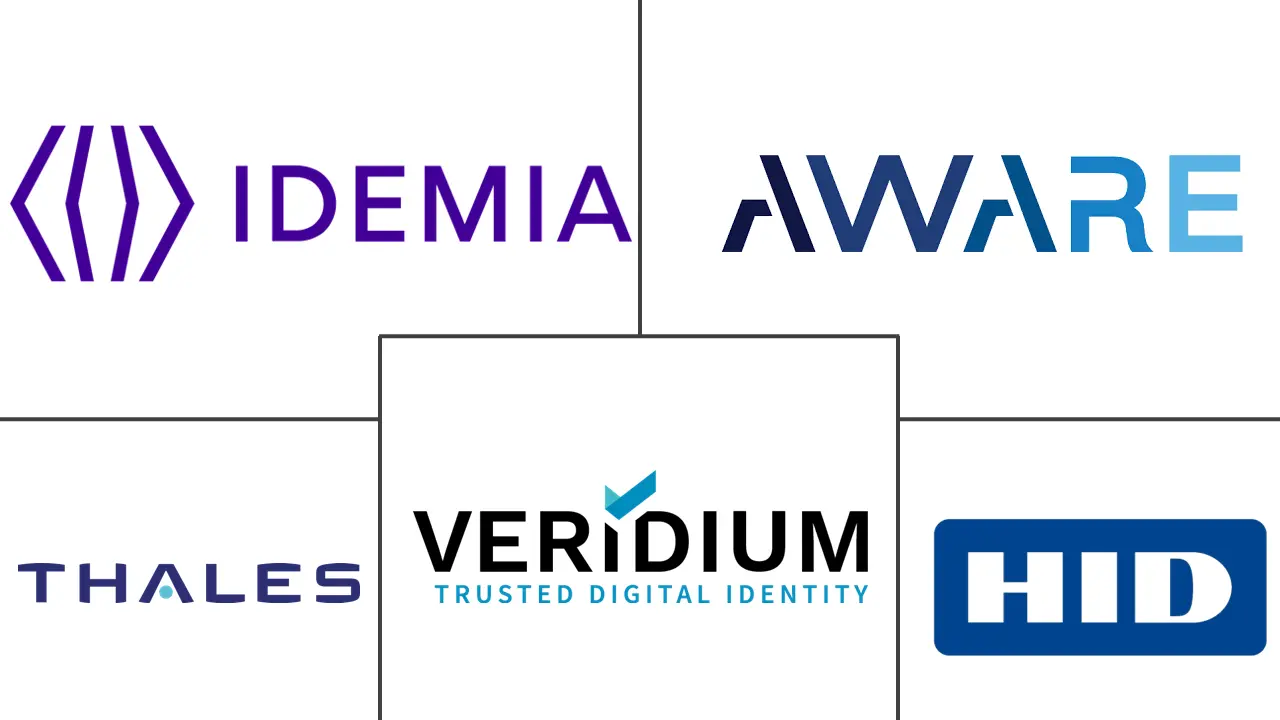Europe BFSI Biometrics Market Size and Share
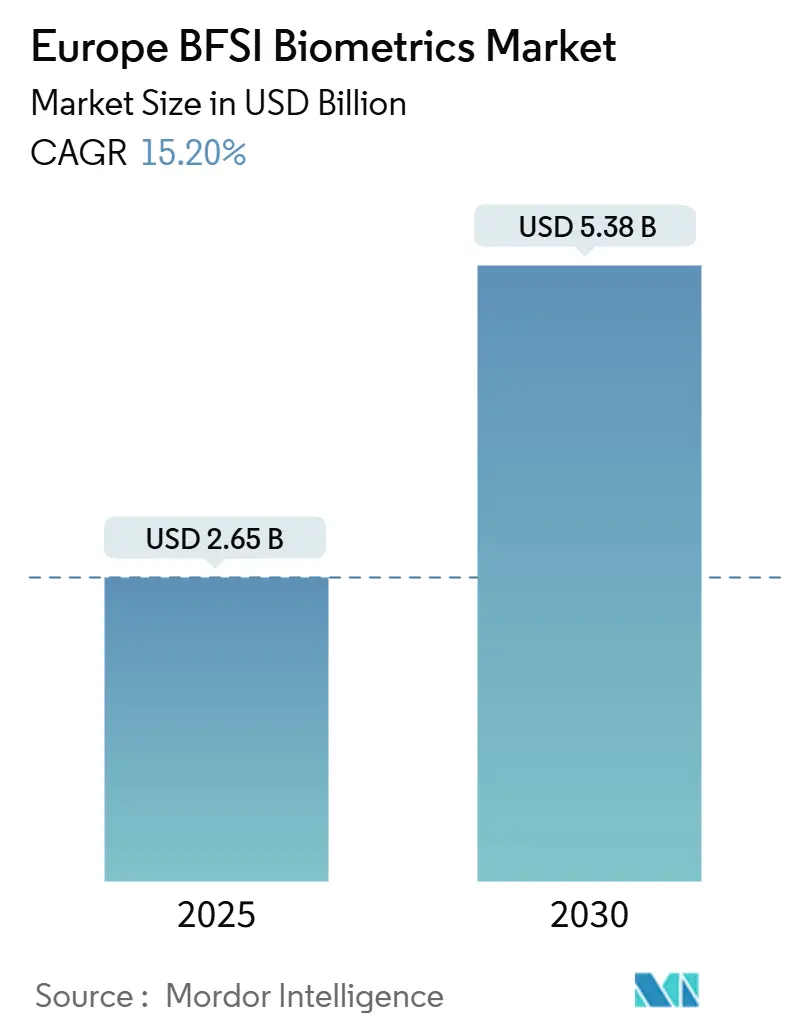
Europe BFSI Biometrics Market Analysis by Mordor Intelligence
The Europe BFSI Biometrics Market size is estimated at USD 2.65 billion in 2025, and is expected to reach USD 5.38 billion by 2030, at a CAGR of 15.20% during the forecast period (2025-2030).
- The increasing digitalization of banking services and biometrics enables banks to improve customer engagement levels, which contributes to the growth of this market. The past decade has witnessed substantial transformations in the banking industry as a result of the influence of digitization. The advent of the digital revolution has completely reshaped the manner in which customers engage with their banks and how banks conduct their operations. The introduction of digitization has effectively enhanced the accessibility and convenience of banking services for customers.
- Biometrics in digital banking is increasing as digitalization advances, and banks and financial institutions need to secure authentication systems to enhance customer experience and protect sensitive information. Authentication methods, such as PINs or OTPs, and passwords are easily stolen, forgotten, or compromised. Hence, biometric verification for bank accounts has become increasingly integral to financial industry security platforms. Biometrics helps boost customer trust in banks and improves banking institutions' brand reputation.
- Biometric authentication is rapidly increasing in the banking industry because of the provision of more secure identity verification processes. Changing customer behaviors led to new embedded finance options, such as the emerging buy-now, pay-later models that have gained a significant share. Almost half of Europeans have already used buy-now, pay-later. Poland and Sweden had maximum usage of 62% and 57%, respectively, while the Czech Republic and Austria had 31% and 33%.
- Furthermore, face recognition services were introduced in the retail banking sector for eKYC services, enabling consumers to take a selfie with a smart device and a copy of their identity document, which was shared with a financial institution. The BFSI biometric face recognition technology has been introduced as an authentication method both online and at ATMs, which offers several benefits to consumers and financial institutions as a contactless interface and can reduce instances of fraud and lost cards.
- The high initial investments required for the development of biometric technology, along with the costs of devices like facial, iris, and vein biometry, are primarily due to extensive research and development efforts, as well as the complexities involved in data analysis through embedded devices.
- Additionally, the expenses related to maintenance and data security are crucial, including the need to maintain data security measures such as anti-virus software, encryption-decryption protocols, and other security measures. The costs associated with the biometric systems increase for all the corrective measures and device maintenance. This, in turn, limits banking and financial institutions from investing in these security and identification systems.
- Furthermore, macroeconomic factors such as government regulations on the adoption of the biometrics market, along with the higher interest rate and geopolitical tensions, have affected the demand for biometrics adoption and impacted the market’s growth.
Europe BFSI Biometrics Market Trends and Insights
Fingerprint Biometric to Hold Significant Market Share
- The fingerprint biometric is a prominent type of biometric used in various devices and application fields. The growing penetration of smartphones equipped with fingerprint biometrics is a prominent driver of the market's growth.
- According to Apple, its net sales in Europe for FY 2023 accounted for more than USD 94 billion, a decrease from the record-breaking USD 95.12 billion achieved across the continent. This signified the sixth occasion when Apple's net sales in Europe surpassed USD 60 billion.
- European banks are dedicating most of their budgets to anti-money laundering and KYC by adopting biometrics and automation technologies to reduce KYC and anti-money laundering costs. For instance, Onfido has collaborated with Italian neo-bank HYPE to automate customer onboarding using biometrics and document verification technologies.
- Owing to the increasing demand for biometric payment cards, fingerprint biometrics is witnessing a significant need in the region. For instance, Crédit Agricole de Lorraine, a French bank, rolled out a biometric payment card that allows one to authenticate contactless payments above USD 53 with their fingerprint and without using a PIN.
- Furthermore, with the increasing risk of mag strips that are easily read and copied, countries like Spain have announced that banks will stop using magnetic strips on their cards and replace existing credit cards with fingerprint biometrics cards.
- According to the report published by the European Central Bank, the European Central Bank reported a 10.1% increase in the total number of non-cash payments during the first half of 2023, reaching 67.0 billion transactions, compared to the same period in 2022.
- In the initial six months of 2023, there was a notable surge in contactless card payments, witnessing a growth of 24.3% to reach 20.9 billion transactions compared to the corresponding period in 2022. Furthermore, the overall value of these transactions experienced a significant rise of 25.9% to reach an impressive EUR 0.5 trillion (USD 0.54 trillion).
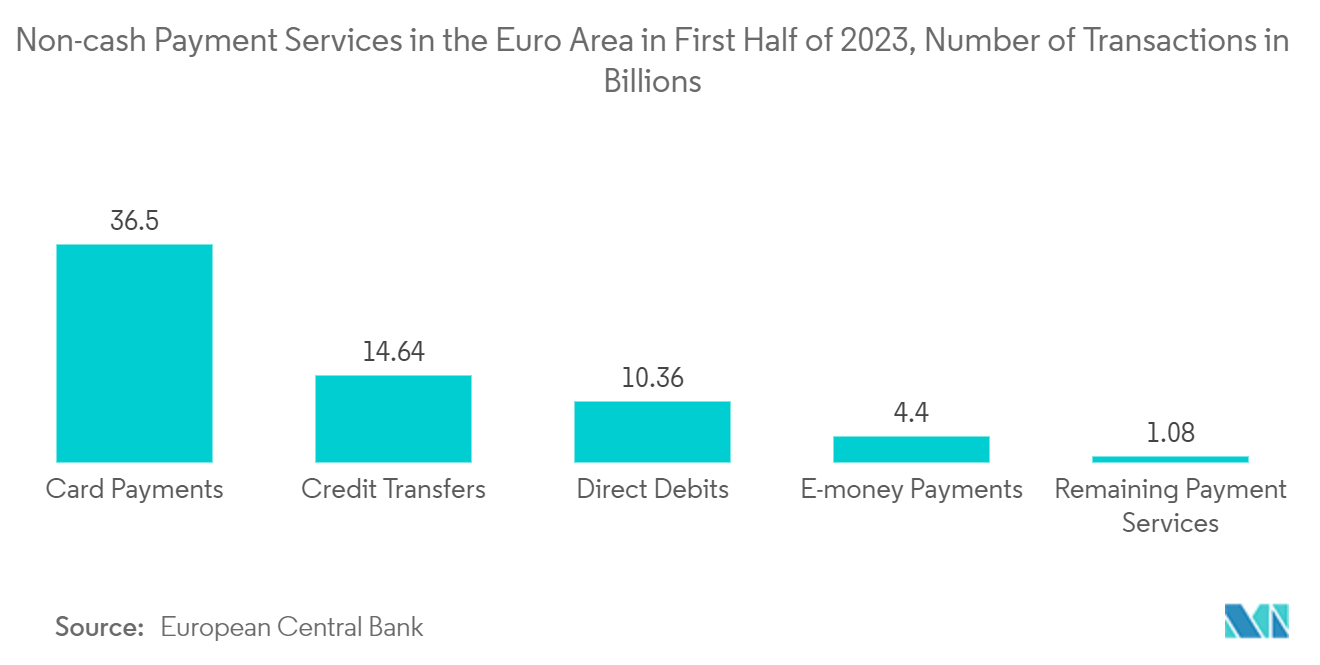
Germany Holds Significant Market Share
- Biometric identification technology has been widely adopted in the country, and the banking industry has advanced by replacing conventional systems with biometric ones. More stringent personnel and customer identification procedures are still required to prevent fraud and identity theft within the region's banking sector, which is rapidly going digital.
- Banks in the country are progressively embracing biometrics as a means to verify the identity of customers who access their services. This inclination is not confined to banks alone; other financial institutions are also adopting biometric authentication to ascertain the identity of customers and protect valuable resources. The surge in financial fraud, identity theft, and cyber threats has compelled banks to revamp their identity protocols, and biometrics in the banking and financial sector provide a viable solution.
- The country is witnessing an increase in online payments, with 68% preferring online payments. To improve services and ensure a central intermediation role in the payment ecosystem, financial institutions have been fervently pursuing standardization initiatives as they are witnessing pressure from significant e-commerce and IT giants like Samsung, Google, and Apple.
- Increasing mobile payment transactions, coupled with growing government and private corporations' initiatives toward adopting biometric authentication systems, are expected to drive the market.
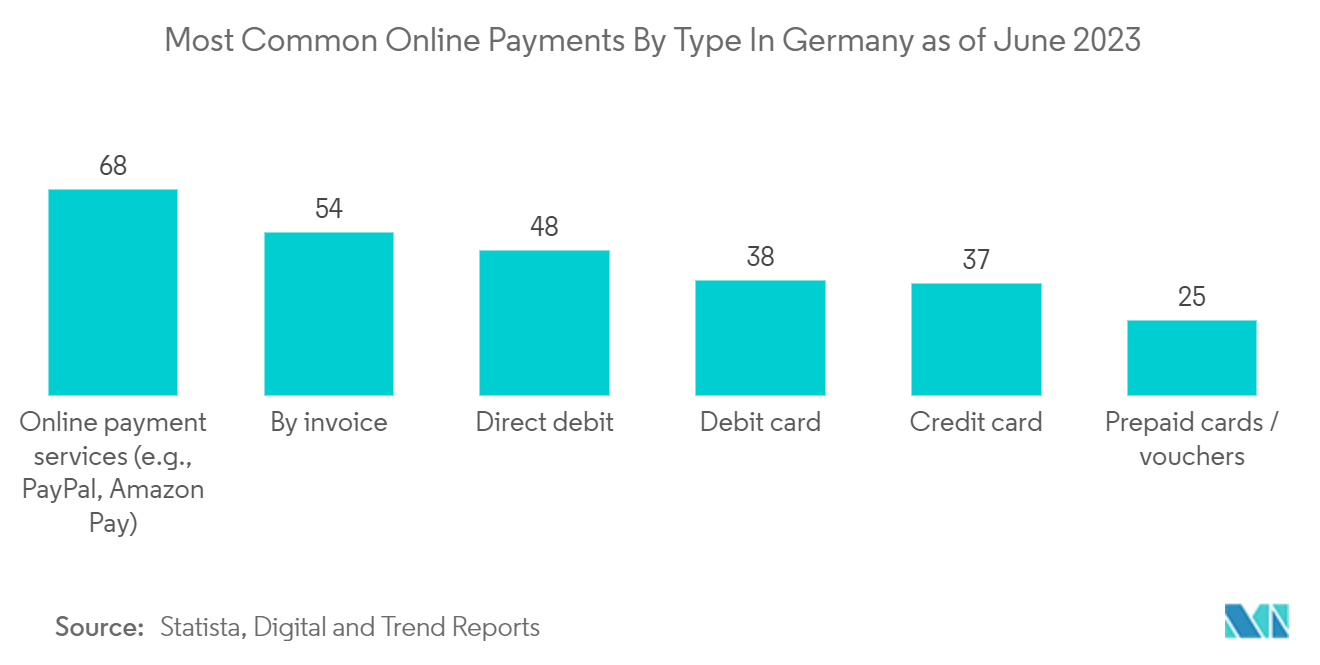
Competitive Landscape
The European BFSI biometrics market is fragmented and consists of several players. Companies in the market continuously try to increase their market presence by introducing new products, expanding their operations, or entering strategic mergers and acquisitions, partnerships, and collaborations. Some of the major players include IDEMIA, Veridium, Thales Group, HID Global Corporation, and Aware Inc.
Europe BFSI Biometrics Industry Leaders
-
IDEMIA
-
Veridium
-
Thales Group
-
HID Global Corporation
-
Aware, Inc.
- *Disclaimer: Major Players sorted in no particular order
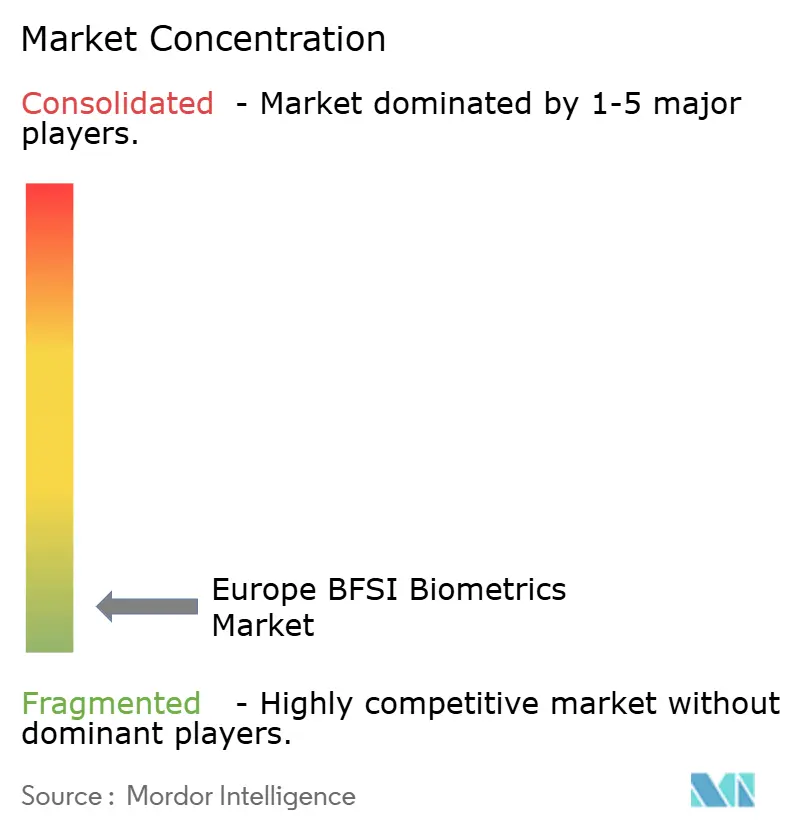
Recent Industry Developments
- March 2024: Mastercard and Nexi announced a strategic partnership to advance open banking payments across Europe. This collaboration will enable seamless e-commerce transactions through Nexi's gateways, benefiting merchants across Europe.
- January 2024: Mastercard announced the launch of an authentication service, enabling consumers to use fingerprints and facial recognition when logging in or making changes to accounts instead of fraud-prone passwords.
Europe BFSI Biometrics Market Report Scope
The study tracks the revenue accrued through the sale of biometrics in the BFSI sector by various players in the European region. The study also tracks the key market parameters, underlying growth influencers, and major vendors operating in the industry, which supports the market estimations and growth rates over the forecast period. The study further analyses the overall impact of COVID-19 aftereffects and other macroeconomic factors on the market. The report's scope encompasses market sizing and forecasts for the various market segments.
The European BFSI biometrics market is segmented by authentication type (single authentication factor, multi-factor authentication), contact type (contact-based, non-contact based), product type (voice recognition, facial recognition, fingerprint identification, vein recognition, iris recognition), application (door security, ATM, internet banking, mobile banking, payment authentication), and country (United Kingdom, Germany, France, Rest of Europe). The market sizes and forecasts are provided in terms of value (USD) for all the above segments.
| Single Authentication Factor |
| Multi-factor Authentication |
| Contact-based |
| Non-contact Based |
| Voice Recognition |
| Facial Recognition |
| Fingerprint Identification |
| Vein Recognition |
| Iris Recognition |
| Door Security |
| ATM |
| Internet Banking |
| Mobile Banking |
| Payment Authentication |
| United Kingdom |
| Germany |
| France |
| By Authentication Type | Single Authentication Factor |
| Multi-factor Authentication | |
| By Contact Type | Contact-based |
| Non-contact Based | |
| By Product Type | Voice Recognition |
| Facial Recognition | |
| Fingerprint Identification | |
| Vein Recognition | |
| Iris Recognition | |
| By Application | Door Security |
| ATM | |
| Internet Banking | |
| Mobile Banking | |
| Payment Authentication | |
| By Country*** | United Kingdom |
| Germany | |
| France |
Key Questions Answered in the Report
How big is the Europe BFSI Biometrics Market?
The Europe BFSI Biometrics Market size is expected to reach USD 2.65 billion in 2025 and grow at a CAGR of 15.20% to reach USD 5.38 billion by 2030.
What is the current Europe BFSI Biometrics Market size?
In 2025, the Europe BFSI Biometrics Market size is expected to reach USD 2.65 billion.
Who are the key players in Europe BFSI Biometrics Market?
IDEMIA, Veridium, Thales Group, HID Global Corporation and Aware, Inc. are the major companies operating in the Europe BFSI Biometrics Market.
What years does this Europe BFSI Biometrics Market cover, and what was the market size in 2024?
In 2024, the Europe BFSI Biometrics Market size was estimated at USD 2.25 billion. The report covers the Europe BFSI Biometrics Market historical market size for years: 2020, 2021, 2022, 2023 and 2024. The report also forecasts the Europe BFSI Biometrics Market size for years: 2025, 2026, 2027, 2028, 2029 and 2030.
Page last updated on:
Europe BFSI Biometrics Market Report
Statistics for the 2025 Europe BFSI Biometrics market share, size and revenue growth rate, created by Mordor Intelligence™ Industry Reports. Europe BFSI Biometrics analysis includes a market forecast outlook for 2025 to 2030 and historical overview. Get a sample of this industry analysis as a free report PDF download.
